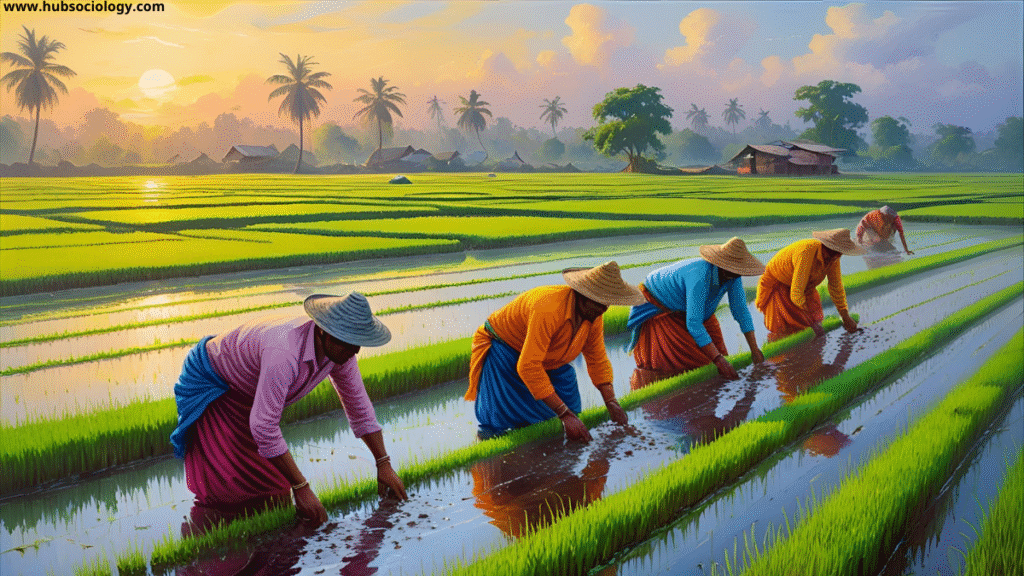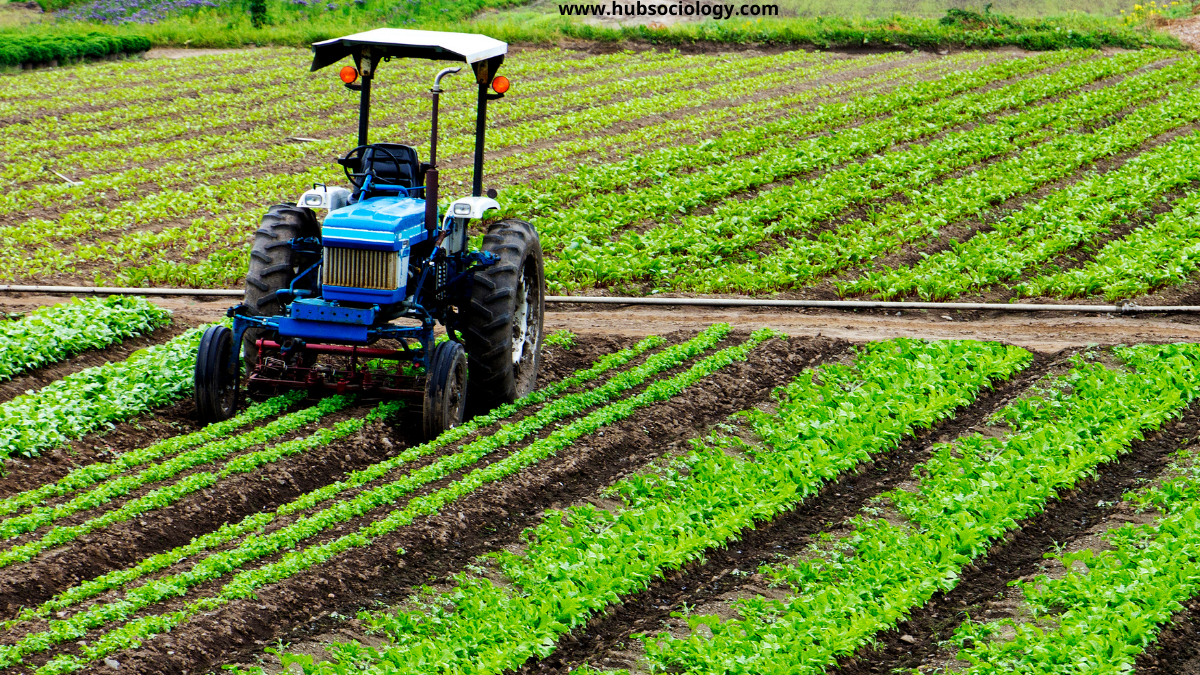Introduction on Agrarian Social Stratification
Agrarian social stratification refers to the structured inequality and hierarchical arrangements that emerge in agricultural societies based on access to land, resources, and power. In sociology, this concept provides insights into how agrarian economies shape social classes, status, and power relations in rural settings. Unlike urban or industrial stratification, agrarian stratification is closely tied to ownership of land, modes of cultivation, and traditional rural institutions. It has historically shaped the social order in many societies, including feudal Europe, caste-based India, and peasant societies in Asia, Africa, and Latin America.
Understanding agrarian stratification is crucial because agriculture remains the livelihood of a significant portion of the world’s population, particularly in developing countries. The stratification patterns not only affect economic opportunities but also influence cultural norms, political alignments, and social mobility.

Theoretical Perspectives on Agrarian Social Stratification
Sociologists approach agrarian stratification from various theoretical lenses:
- Marxian Perspective
Karl Marx emphasized the role of class conflict in agrarian society. For him, landowners represented the exploiting class, while peasants and agricultural laborers were the exploited. In feudal Europe, the landlord–serf relationship exemplified this conflict. Later, in capitalist agriculture, differentiation between rich peasants, middle peasants, and landless laborers became evident. Marxists argue that land relations reflect broader patterns of exploitation and surplus extraction. - Weberian Perspective
Max Weber expanded the analysis beyond economic class by including status and power. In rural societies, stratification may not only be based on landownership but also on caste, kinship, religion, or political influence. For example, in India, the landowning castes enjoyed both economic dominance and high social status. - Functionalist Perspective
Functionalists argue that stratification in agrarian societies ensures the allocation of land, labor, and responsibilities in ways that sustain agricultural production. While inequality exists, it may be rationalized as necessary for the functioning of traditional rural communities. - Dependency and World-Systems Theories
In the global South, agrarian stratification is shaped not only internally but also by colonialism and global capitalism. Plantation economies in Latin America or cash-crop production in Africa were structured to serve external markets, leading to unequal land distribution and exploitation of local peasants.
Dimensions of Agrarian Social Stratification
- Land Ownership
Land is the most decisive factor in agrarian stratification. Those who own large estates or fertile land hold significant power, while the landless depend on wage labor or tenancy. Land ownership is also a source of prestige, inheritance, and influence in rural society. - Tenancy and Sharecropping
In many agrarian systems, tenants cultivate land owned by landlords, often paying rent in cash, kind, or a share of the harvest. Sharecropping systems, such as the zamindari in colonial India or the hacendado system in Latin America, perpetuated inequality and dependency. - Caste and Kinship
Particularly in South Asia, agrarian stratification overlaps with caste hierarchies. Landownership often concentrated in dominant castes, while marginalized castes performed labor-intensive agricultural work. Kinship networks also reinforced power and status in village life. - Gender Relations
Women in agrarian societies are often excluded from landownership and decision-making. Despite being central to agricultural labor, patriarchal norms limit their access to property rights and resources. Thus, gender inequality is a key dimension of agrarian stratification. - Political Power
Local elites, often large landowners, dominate village councils, panchayats, or other rural governance structures. Their control over land translates into political influence, reinforcing the cycle of dominance and inequality. - Market Integration
The extent to which rural economies are integrated into markets also affects stratification. Small farmers may be disadvantaged in competing with large commercial farmers who have better access to credit, technology, and markets.

Historical Patterns of Agrarian Social Stratification
- Feudal Europe
During medieval times, agrarian stratification revolved around the lord–serf relationship. Serfs were bound to the land and owed labor or rent to landlords. This system institutionalized inequality and severely restricted social mobility. - Colonial Agrarian Structures
Colonialism reshaped rural societies by introducing systems of taxation, land revenue collection, and commercial crops. In India, the British introduced zamindari and ryotwari systems, leading to landlord dominance and peasant impoverishment. Similarly, in Latin America, Spanish and Portuguese colonists established haciendas where indigenous peasants worked under exploitative conditions. - Post-Colonial Land Reforms
Many countries attempted land reforms to address agrarian inequality. For instance, India undertook land ceiling acts and tenancy reforms; China redistributed land during the Communist revolution; and Mexico enacted reforms after its revolution. While these reforms reduced extreme inequalities in some regions, in many cases landlords adapted to maintain control, and stratification persisted. - Green Revolution
The introduction of high-yield seeds, fertilizers, and irrigation in the mid-20th century created new forms of stratification. Wealthier farmers benefited from technology and expanded production, while smallholders and landless laborers often fell behind, leading to a widening rural divide.
Agrarian Stratification in Contemporary Society
- Persistence of Inequality
Despite modernization, agrarian stratification continues in many societies. In India, for example, dominant castes still control large tracts of land, while Dalits and Adivasis remain marginalized. In Africa and Latin America, land concentration in the hands of elites persists. - Globalization and Agribusiness
The rise of agribusiness and corporate farming has altered stratification patterns. Small farmers face displacement as multinational corporations expand contract farming and commercial agriculture. This results in a shift from traditional landlord–peasant relations to farmer–corporate dependency. - Rural-Urban Migration
Agrarian stratification pushes many landless or small farmers to migrate to cities in search of work. This migration creates new urban poverty while leaving behind an increasingly polarized rural society. - Resistance and Movements
Stratification in agrarian societies has also given rise to resistance. Peasant uprisings, land rights movements, and farmer protests are expressions of discontent against inequality. Movements such as the Naxalite insurgency in India or the Zapatista movement in Mexico highlight struggles for land redistribution and dignity. - Environmental and Climate Challenges
Climate change and environmental degradation add another dimension. Marginal farmers and landless laborers are most vulnerable to floods, droughts, and declining soil fertility, exacerbating stratification in rural communities.
Sociological Implications on Agrarian Social Stratification
- Class Formation in Rural Areas
Agrarian stratification demonstrates how social classes evolve around land, labor, and surplus extraction. It illustrates Marx’s theory of exploitation and class struggle in rural contexts. - Intersectionality
Stratification in agrarian societies cannot be understood in purely economic terms. It intersects with caste, ethnicity, gender, and kinship, making it a multidimensional phenomenon. - Social Mobility
Agrarian stratification restricts upward mobility, particularly for the landless and marginalized. However, education, migration, and alternative livelihoods provide limited pathways for breaking the cycle. - Continuity and Change
While modernization, reforms, and globalization have altered the patterns of agrarian inequality, the fundamental dynamics of land-based stratification remain remarkably persistent.
Conclusion on Agrarian Social Stratification
Agrarian social stratification is a defining feature of rural societies, rooted in unequal access to land, resources, and power. From feudal Europe to colonial empires and contemporary global capitalism, agrarian stratification has shaped not only economic conditions but also cultural values, political systems, and social relations. Despite reforms and technological advances, inequalities remain deeply entrenched, especially in the Global South.

Sociologically, agrarian stratification is significant because it exemplifies how structural inequalities reproduce themselves through class, caste, gender, and power dynamics. As agriculture faces new challenges in the 21st century—such as globalization, corporate farming, and climate change—the study of agrarian stratification remains vital for understanding rural inequality and envisioning more equitable futures.
Exam-Style Questions on Agrarian Social Stratification
Short Answer Questions on Agrarian Social Stratification (2–3 marks)
- Define agrarian social stratification.
- What is the role of land ownership in rural stratification?
- Mention two features of tenancy systems in agrarian societies.
- How does caste intersect with agrarian stratification in India?
- What is sharecropping? Give one example.
Short Essay Questions on Agrarian Social Stratification (5 marks)
- Explain Marx’s view of agrarian stratification.
- How does Weber’s perspective differ from the Marxian approach in explaining agrarian inequality?
- Discuss the impact of the Green Revolution on agrarian stratification.
- How do gender relations shape agrarian inequality?
- Describe the role of colonialism in structuring agrarian hierarchies.
Long Answer Questions on Agrarian Social Stratification (10–15 marks)
- Analyze the major dimensions of agrarian social stratification with suitable examples.
- Discuss historical patterns of agrarian stratification in feudal, colonial, and post-colonial contexts.
- Evaluate the impact of globalization and agribusiness on rural stratification.
- How do peasant movements and rural protests challenge agrarian inequality?
- Critically examine the persistence of agrarian stratification in contemporary societies despite modernization and reforms.
